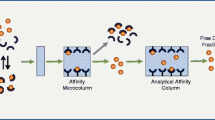Summary
Sera from 17 patients with Type I diabetes and 19 healthy volunteers have been examined to evaluate whether the kinetics of the binding of drugs to Site II of serum albumin is altered in diabetes. Stopped-flow measurements showed that the association velocity and the affinity constants of the fluorescent marker dansylsarcosine were significantly lower in diabetics (160 s−1 and 2.0 × 105 l·mol−1) than in non-diabetics (196s−1 and 4.0 × 105 l·mol−1). The dissociation velocity was not different [20.3 s−1 vs. 19.4 s−1]. Although patients with a reduced albumin concentration were excluded the diabetics had significantly lower concentrations than the healthy volunteers. There was a significant correlation between decreased glycosylation of albumin and increased association velocity. The dissociation velocity constants were correlated with the molar concentration ratio of free fatty acids/human serum albumin. Thus, the extent of glycosylation and the amount of fatty acids bound per mole albumin can both affect the kinetics of drug binding to Site II. The lower affinity in patients with Type I diabetes is due to the increased in the glycoalbumin concentration.
Similar content being viewed by others
References
Day JF, Thorpe SR, Baynes JW (1979) Nonenzymatically glucosylated albumin. J Biol Chem 254: 595–597
Dolhofer R, Wieland OH (1980) Increased glycosylation of serum albumin in diabetes mellitus. Diabetes 29: 417–422
Shaklai N, Garlick RL, Bunn HF (1984) Nonenzymatic glycosylation of human serum albumin alters its conformation and function. J Biol Chem 259: 3812–3817
Tsuchiya S, Sakurai T, Sekiguchi S-I (1983) Nonenzymatic glucosylation of human serum albumin and its influence on binding capacity of sulfonylureas. Biochem Pharmacol 33: 2971–2976
Barry MG, Collins WJC, Feely J (1986) Plasma protein binding of drugs in insulin-dependent diabetes mellitus. Br J Pharmacol 89: 719
Kemp F, Kearns GL, Turley CP (1987) Alteration of phenytom binding by glycosylation of albumin in IDDM. Diabetes 36: 505–509
Iberg N, Flückiger N (1986) Nonenzymatic glycosylation of albumin in vivo: identification of multiple glycosylated sites. J Biol Chem 261: 13542–13545
Wörner W, Pfleiderer S, Kratzer W, Rietbrock N (1990) Nichtenzymatische Glykosylierung von Humanserumalbumin: Einfluß auf die Bindungskinetik an der Benzodiazepinbindungsstelle. J Clin Chem Clin Biochem 28: 527–531
Garlick L, Mazer JS (1983) The principle site of nonenzymatic glycosylation of human serum albumin in vivo. J Biol Chem 258: 6142–6146
Shimizu S, Tani Y, Tabata M, Murachi T (1980) Enzymatic determination of free fatty acids: a colorimetric method. Anal Biochem 107: 193–198
Rodkey FL (1965) Direct spectrophotometric determination of albumin in human serum. Clin Chem 11: 478–487
Lloyd DR, Nott M, Marples J (1985) Comparison of serum fructosamine with glycosylated serum protein (determined by affinity chromatography) for the assessment of diabetic control. Diabetic Med 2: 474–478
Lassmann A (1980) Stopped-flow investigations on the kinetics of drug binding to human serum albumin. In: Rietbrock N, Woodcock BG (eds) Progress in drug protein binding. Vieweg, Braunschweig, 17–29
Taylor WP (1972) Fast reactions-flow and relaxation methods. In: Chignell CF, Schwartz A (eds) Methods in pharmacology, Vol. 2 Physical methods. Appleton-Century-Crofts, New York, pp 351–380
Wörner W (1989) Hemmung der Pharmakon-Eiweißbindung an der Benzodiazepin-Bindungsstelle von Humanserumalbumin durch nichtkovalent and kovalent gebundene endogene Liganden. Dissertation, Frankfurt am Main
Pfleiderer S, Wörner W, Rietbrock N (1989) Does the non-enzymatic serum albumin glycosylation in diabetes inhibit benzodiazepine binding? Evidence from fast reaction binding studies in vitro. Eur J Clin Pharmacol 36 [Suppl]: A65
Cohen MP (1986) Diabetes and protein glycosylation: measurement and biological relevance. Springer, New York
Menke G, Wörner W, Kratzer W, Rietbrock N (1989) Kinetics of drug binding to human serum albumin: allosteric and competitive inhibition at the benzodiazepine binding site by free fatty acids of various chain lengths. Naunyn-Schmiedeberg's Arch Pharmacol 339:42–47
Author information
Authors and Affiliations
Rights and permissions
About this article
Cite this article
Wörner, W., Preissner, A. & Rietbrock, N. Drug-protein binding kinetics in patients with Type I diabetes. Eur J Clin Pharmacol 43, 97–100 (1992). https://doi.org/10.1007/BF02280763
Received:
Accepted:
Issue Date:
DOI: https://doi.org/10.1007/BF02280763




